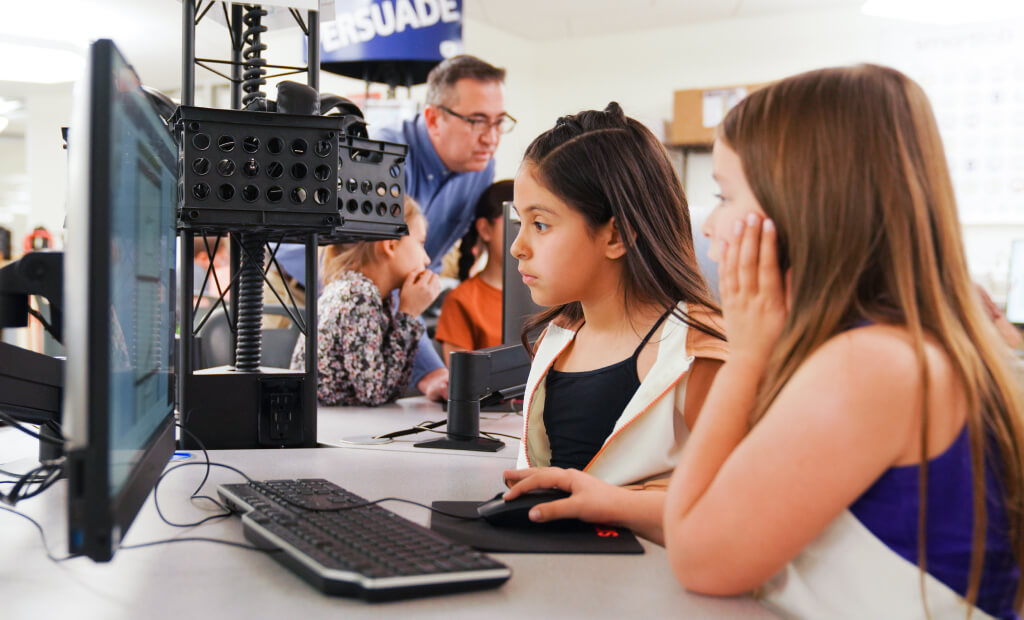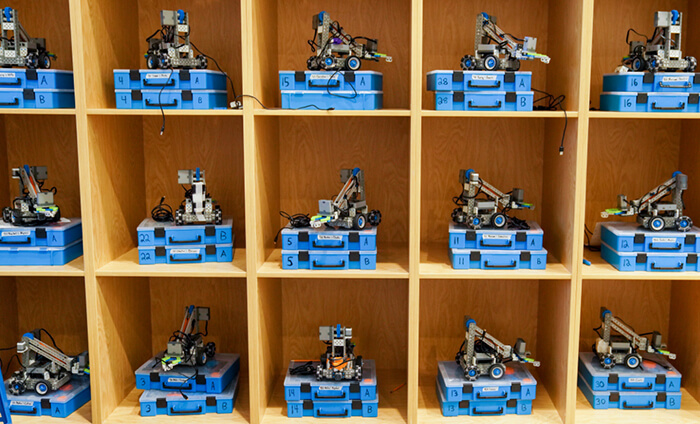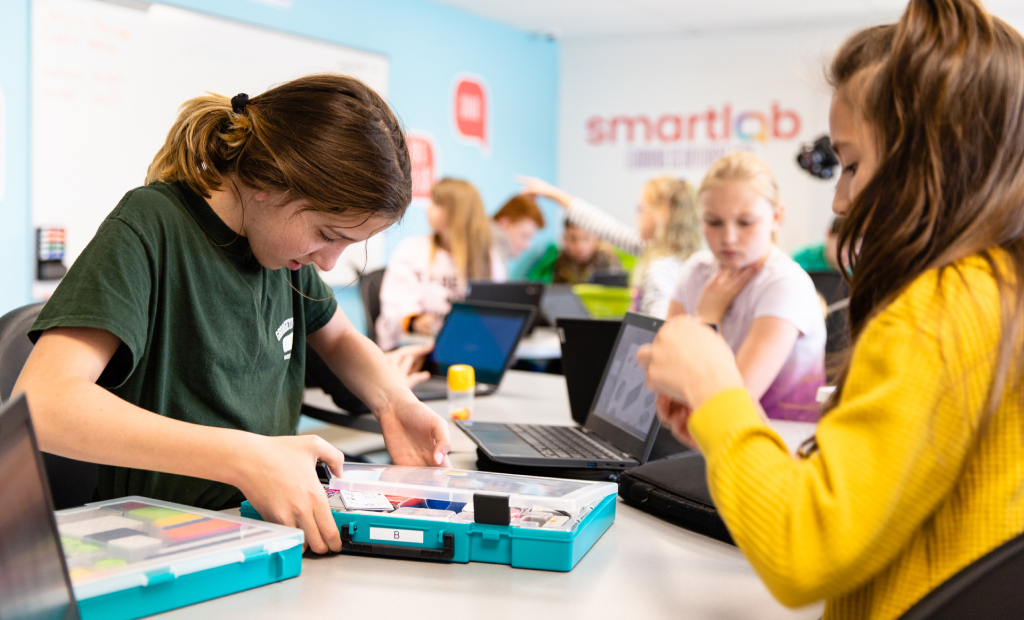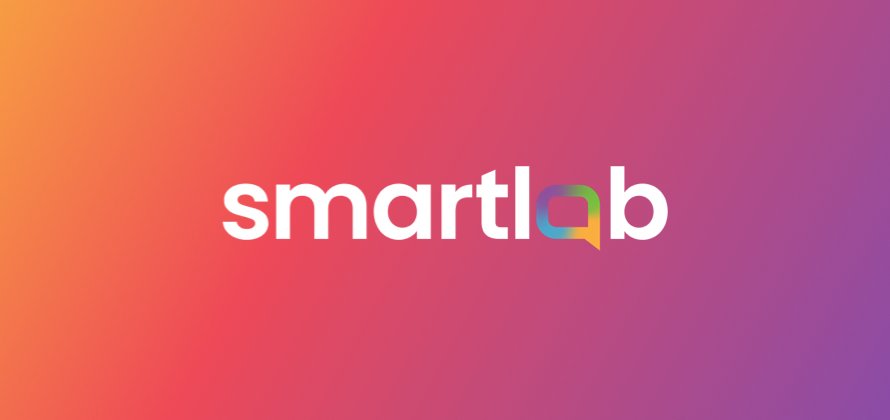Breaking Barriers: Promoting Equity and Inclusion in K-12 Education
Every classroom in the world is filled with students and teachers who bring their own unique perspectives to the table. Each of these perspectives is informed by an individual’s background, past experiences, assumptions, biases, traumas, and identity—some of which may be unfamiliar or at odds with others’.
In recent years, there has been a growing awareness around the need for increased justice, equity, diversity, inclusion, and belonging in K–12 classrooms, a conversation that gained significant momentum during the COVID-19 pandemic. As schools transitioned to remote learning, vast discrepancies became apparent in the way students access and receive support through school. Even though most U.S. schools are entirely back to in-person learning, the challenge of providing equitable support persists.
So how can teachers promote an equitable, inclusive classroom that meets the needs of all students? First, we must understand the difference between equality and equity and how they relate to students’ learning.
Understanding Equity and Inclusion
Many of us were taught from a young age that equality among and between people is the ultimate goal—but this disregards the fact that each of us has different needs, wants, means, abilities, and identities, and that a state of equality may not allow some people to thrive.
In the classroom, equality means that all students receive the same resources, support, and opportunities—nothing more, nothing less, and nothing different from their peers. For example, in order to complete a math quiz, every student might receive a pencil, a calculator, and a paper copy of the same test. While this may seem fair at first, keep in mind that these resources may not support a student with limited vision, a student whose first language is not English, or a student who has advanced beyond their peers and is at risk of becoming disengaged without more challenging assessments.
This scenario highlights the importance of equity in the classroom, or every student getting what they need to succeed. In the math quiz example, each student would receive the tools they need to complete the assignment and have an equal chance to demonstrate their knowledge. A visually limited student may receive a digital version of the test that is compatible with a screen reader; an ESL student may receive a version of the test in their first language or be supported by a bilingual aide throughout. Though it may not seem like a student who excels at math would need extra support, students like this may be tested at a more advanced level in order to stay engaged with the content.
Cultural responsiveness is also a major factor in creating an equitable learning environment. Students from different backgrounds or cultures may demonstrate or present their knowledge in different ways; educators can support these students by allowing them to choose their own forms of assessment. This highlights the fact that equitable support may look different from one student to the next. Factors such as race, language, ethnicity, sexual orientation, or religion may contribute to students needing different types of support and resources in the classroom, but none of these factors should stand in the way of a students’ success.
In addition to providing the necessary support, teachers need to ensure that their own perspectives do not occlude or negate those of their students, a risk that comes with the teacher being the de facto authority figure. Working to overcome one’s biases is an ongoing process, but teachers have a daily opportunity to learn from their students and respond to their unique needs in a way that prioritizes their academic success.
RELATED READING: Providing Equitable Services To Students With Special Needs>>
Barriers to Equity and Inclusion in Education
Whether we are conscious of it or not, myriad factors and characteristics determine how we treat fellow humans. These factors can sometimes contribute to inequitable treatment, whether intentional or unintentional, which then creates barriers between people with different life circumstances.
In school, common factors that can pose barriers to a student’s equitable education include:
- Racial, ethnic, and cultural bias
- Socioeconomic disparities
- Cognitive and physical disabilities
- Gender identity and expression
- Sexual orientation
- Language and linguistic diversity
- Religion
- Immigration status
- Mental health
- Life experiences
- Parents’ or caregivers’ education level
- Home life and responsibilities
- Complex social and emotional challenges
Unfortunately, the U.S. education system historically fails to provide adequate support for students who are most vulnerable to these kinds of barriers, including students of color, children of immigrants, students with physical or cognitive disabilities, students living below the poverty line, and neurodivergent students. However, it’s important to note that the current majority of public school students in the U.S. are non-white, while the majority of teachers remains white—a situation that presents a pressing case for educating teachers on the need to work through their biases and promote equity, inclusion, diversity, social justice, and belonging in every classroom.
While the Black Lives Matter movement has prompted widespread conversations about race in schools across the country (and the world), race poses only one potential barrier to an equitable education system. Socioeconomic disparities among school-aged children came to the forefront during the COVID-19 lockdowns of 2020 and 2021, as students were expected to keep up with their schoolwork from home, despite many students lacking access to a computer, reliable internet, or even a quiet place to study. These disparities certainly existed before the pandemic, but the sudden transition to remote learning made them highly visible to educators, administrators, and the country at large.
The U.S. education system still has a long way to go in mitigating the barriers highlighted by COVID-19, but the creation of thousands of diversity, equity, and inclusion (DEI) initiatives and programs across the country is keeping the conversation alive.
SmartLabs have absolutely brought both girls and people of color into the STEM fields at our high schools.
— Brian Ewert
Superintendent
Littleton Public Schools, Colorado
RELATED READING: Equal Access to Quality Project-Based Learning For Rural Students>>
The Role of Teachers and Educators

Promoting equitable and inclusive classrooms is a group effort, one that requires work from the institutional level down to the personal level.
The Every Student Succeeds Act (ESSA) was signed into law by President Barack Obama in 2015, building upon the previous version, No Child Left Behind. The provisions included in ESSA are meant to ensure that all students receive access to a high quality education, regardless of race, gender, ability, socioeconomic status, language, zip code, or background. In its new iteration, ESSA outlines how educators can instill and foster equity at three levels:
- Institutional: The policies put in place by school administration, as well as the values they uphold.
- Instructional: Any lesson plans, books, assignments, or teaching strategies used in the classroom.
- Personal: The ways in which individual teachers engage with the process of promoting equity.
To foster and promote equity at each level, educators can:
- Ensure the curriculum is representative and inclusive: Course content should highlight the experiences and contributions of people from a wide range of backgrounds and identities. Pay special attention to content or concepts that may exclude or be inaccessible to certain students; this can be as simple as reframing an assignment to “interview your parents” into “interview an adult who lived during a certain time period,” since some students may not live with or have access to their parents.
- Align your grading practices to remove teacher biases: Don’t limit your assessment to what students demonstrate on paper. Take a holistic approach to grading, accounting for class participation, in-class work, homework, projects, exams, and any extra credit work. Likewise, avoid grading all students according to one limited measure of success. For example, students who engage in classroom discussions and seem to grasp course content may struggle to complete exams or turn in their work on time, which may be an inaccurate reflection of their engagement or content mastery. Acknowledge that certain students need accommodations to succeed, such as extra time to complete projects, a different type of exam from their peers, or a chance to re-do assignments. Doing so will give students hope and confidence that their teachers believe in them and want them to succeed.
- Schedule regular one-on-one conferences with each student: Make time to talk with each student privately at least once per grading period. Use this opportunity to hear what students need or want in the classroom, any challenges they’re facing, any special interests they have around course content, or anything they may be uncomfortable addressing in front of their peers. These conversations can reveal a lot about the kinds of support individual students need to achieve their potential in the classroom.
- Allow voice and choice for assignments: Check in with your students regularly to see if their education is “working” for them. In other words, ask them what they want to learn, how they want to learn it, where and when they feel they learn best, and what they want as an outcome. Depending on your school’s standards framework, try to incorporate student voice and choice in as many lessons and engagements as you can.
- Get to know your students: Your students spend a great deal of time in school, but they have full lives outside the classroom. Cultivate genuine curiosity about their interests, aspirations, passions, and concerns—not only as they pertain to schoolwork, but to their personhood. This will help you build your curriculum out with relevant content that engages students authentically and respects their interests.
- Know how to address your students: Know how to pronounce your students’ names, what pronouns they prefer, and how they would (or would not) like to be identified. When in doubt, just ask—this demonstrates that you care about respecting your students’ unique identities, which can be immensely empowering for young people.
- Recognize progress and success: Tell students directly when you notice them making progress, however small. A student with ADHD may regularly have trouble sitting still; tell them when you notice they are putting in extra effort to focus on the lesson. If a student who is usually silent in class contributes to a classroom discussion, recognize both their contribution and effort. You know your students best, but some students may be more comfortable receiving recognition in private; when in doubt, err on the side of one-on-one recognition, and ask them if they would mind being recognized in front of their peers.
- Provide equitable attention: Don’t assume that students without IEPs or ILPs don’t also have unique needs or “invisible” disabilities. Likewise, don’t assume that students on a Gifted and Talented track are fine on their own. Too often, advanced students get short shrift when teachers focus on differentiating to catch less successful students. Advanced students “do the work” and often learn nothing. The most effective teachers enlist tools and approaches that help students find their own Zones of Proximal Development (what a learner can do with guidance or collaboration) or at least work inside it.
- Include students in making classroom decisions: The classroom belongs to students as much as it belongs to their teacher, so asking for their input on decisions regarding routines, procedures, and even assessments gives them ownership over their educational experience. This shifts any ingrained power dynamic to a more equitable place, giving students a sense of agency.
Equitable Curriculum and Teaching Methods
Elements of education that support diversity and inclusion:
- Diverse representation in curriculum
- “Representation” in this context means that when students see individuals similar to them in their learning materials, they are more likely to feel like they belong in that subject and can picture themselves being a part of it. Conversely, students who only see people who are different from them in materials, the more likely they are to feel like they do not belong or cannot participate in activities those materials portray.
- Inclusive learning materials and resources
- In addition to representation in resources, “inclusivity” can refer to making materials accessible to students with different abilities. Using text as an example, this might include making reading material available at different reading levels or in different languages, providing audio (see: LearningHub) or braille versions of text, or providing manipulatives to help students understand a concept more clearly.
- Engagements that connect directly to students’ lives
- Students engage in school work and synthesize learning more readily when they are couched in terms and situations they identify with.
Define and discuss teaching styles and methods that support equity and inclusion:
- Differentiated instruction
- Culturally responsive teaching
- Inclusive teaching for special needs students
- Scaffolding lessons (See: Personalized Learning, Documenting Learning)
Campos EPC-funded SmartLab
See the STEM lab experience through the eyes of a young student with dyslexia and ADHD.
Creating an Equitable Learning Environment
An equitable learning environment is both a physical and theoretical concept. Of course it requires careful consideration of the types of available project space, the furniture, sightlines, accessibility accommodations, and more—but it also extends to the way students and teachers treat each other, the expectations they have for one another, and the level of agency they feel in that space.
Here are a few ways you can adjust both your physical classroom space and your overall instructional approach to create an environment that fosters equity:
- Experiment with flexible seating: Embrace various seating arrangements to accommodate different learning preferences and physical needs. Allow students to choose where they sit to promote optimal comfort and engagement.
- Offer choice in learning engagements: Create learning stations with options such as video, audio, small group activities, hands-on projects, and teacher-guided sessions. This empowers students to select methods that align with their strengths and preferences.
- Address challenging conversations as they come up: Foster an environment where challenging conversations about harmful behavior or remarks can occur openly and safely. It may not be easy at first! But there are plenty of educator resources that provide guidance on helping students understand the impact of their words and actions.
- Advocate for all students’ needs: Be mindful of your own individual biases and assumptions when it comes to physical, cultural, behavioral, and experiential differences. Actively advocate out loud for the needs of every student, regardless of their circumstances or backgrounds.
- Accommodate family and work obligations: Recognize that students may have family or work commitments that interfere with their schoolwork. Offer pre-recorded lessons and deadline extensions, or limit homework assignments to ensure they can balance their responsibilities.
- Respect cultural and religious diversity: Consider the cultural and religious obligations of students when planning schedules and activities, and provide flexibility to accommodate those needs. Depending on the situation, this may even present an opportunity to incorporate relevant and timely cultural content into your lessons.
- Diverse assessments and choice: Offer a variety of assessment methods beyond traditional written tests, such as oral exams, group projects, and vlogs, and allow students to choose the assessment formats that best help them show what they know.
- Provide assistive technology: Ensure students with both physical and cognitive disabilities have access to assistive technology and learning tools to succeed alongside their classmates.
- Engage introverted students: Using a range of tools and strategies such as online games, exit slips, discussion boards, and think-pair-share exercises, you can encourage participation from introverted students who may be less vocal in traditional classroom settings.
- Respect and value every opinion: Create an atmosphere where every student feels their opinions and experiences are respected and valued, regardless of how they express themselves or the language they use.
- Accessible teaching materials: Ensure all teaching materials are accessible to every student. Offer content through various multimedia options, allowing students to choose the medium that suits their preferred learning style.
- Optimize your classroom layout: Prioritize a floor plan that is physically accessible to all, removing barriers for students with mobility challenges.
By implementing these strategies, schools can foster an inclusive and equitable learning environment that honors the unique needs and preferences of each student, ultimately promoting academic success and personal growth for all.




